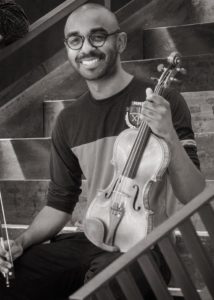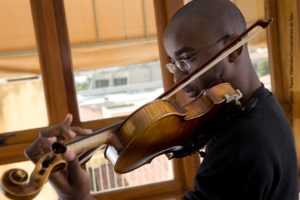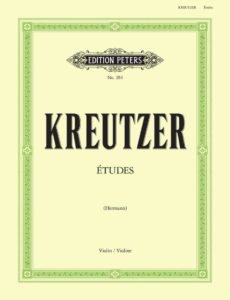RODOLPHE KREUTZER 42 VIOLIN ÉTUDES
BRIDGING THE GAP BETWEEN CLASSICAL AND ROMANTIC VIOLIN REPERTOIRE
by Marcos Santos
 Pedagogical value
Pedagogical value
Kreutzer’s Études are extremely useful to violin teachers globally, as evidenced by the fact that they have been used in many parts of the world since Kreutzer first composed them in 1796. Some modern violinists and pedagogues, such as Ivan Galamian and Max Rostal, have modified them for their own teaching purposes. In the same manner, I have expanded and modified ten of the 42 Études to enhance their pedagogical value. I accomplished this by increasing the number of technical problems addressed in each étude. This approach was taken as it is easier to learn new aspects of technique through a piece that is already familiar to the player. This article is taken from my thesis about Kreutzer, demonstrating the practical applications of these études in teaching by linking them to specific examples from the violin repertoire.
Etudes
The word étude is the French equivalent of “study.” It signifies a short piece used to develop and explore specific technical aspects of an instrument. 20th-century composers also used the term to indicate the exploration of specific aspects of a composition. Grove Music Online defines étude as “An instrumental piece, usually of some difficulty...primarily to exploit and perfect a chosen facet of performing technique, but the better for having some musical interest.” Historically, the term “étude” during the 19th century denoted a short composition with a specific pedagogical purpose. Even though many compositions and instrumental treatises throughout history had didactic intent, they were not designated études
Études can be subdivided into three categories: exercise, étude, and concert étude (caprice). The exercise is an excerpt with a specific technical challenge. Its purpose is to improve a particular aspect of technique. It does not need to be musically relevant, and its length can range from one to several measures. Otakar Sevcik, Henry Shradieck, Gaylord Yost, and Carl Flesch are some pedagogues known for their violin exercises.
Rodolphe Kreutzer’s 42 Études
Rodolphe Kreutzer (1766-1831) was a French violin virtuoso, composer, and conductor. In The Cambridge Companion to the Violin, Stowell asserts that Kreutzer was one of the major French pedagogues of the 19th century.8 He is also famous for having one of Beethoven’s most important violin and piano pieces, Kreutzer Sonata, op. 47, dedicated to him.
Kreutzer combined in equal proportion the pedagogical benefits of an étude with the musical satisfaction of a composition. His études fulfilled the technical demands of the classical music era. Romantic composers and their successors increased these demands. Violin technique continued its evolution during Kreutzer’s lifetime, but his book of études left out many of these new developments. However, it is known that he taught more advanced versions of his études to his students. One of the most important aspects of Kreutzer’s 42 études is the role of the bow in the classical era.
Kreutzer’s collection of 42 études was arranged according to specific technical aspects rather than any progressive difficulty. Études 1 to 14 present a variety of bow strokes and left-hand coordination work. Études 15 to 22 provide trill exercises. Étude 23 emphasizes bow control. Études 24, 25, and 26 explore octaves, broken octaves, and tenths. Études 27 to 31 strengthen more complex string crossings, bow distribution, shifting, and articulation. Finally, Études 32 to 42 present double stops in a variety of settings.

Marcos Vinicius Miranda dos Santos received his doctorate in violin performance at the University of Alabama. Born in Bauru, Brazil, Santos spent most of his life close to home. When he won a national violin competition, he earned a scholarship to the University of Southern Mississippi to pursue a master’s degree in performance violin. Santos is a university professor in Brazil and Professor at Conservatório de Tatuíand and Sócio Proprietário at Bravo Academia de Música. Marcos is also a former Professor de Violino at Universidade Estadual de Campinas. His passion is to inspire students, to pass on his knowledge, and to convey the passion for classical music.
Kreutzer Masterclasses with Natalia Lomeiko
Series I
In the courses and collection section of iClassical Academy, all Kreutzer 42 Etudes are covered by the Masterclass series of Dakapp/Naxos. The first 5 etudes are now available online, either to be purchased as an individual course or as part of the monthly/yearly Master Memberships.
The first series of the KreutzerViolin Etudes Masterclasses with Natalia Lomeiko contain:
- No. 1 in A minor, Adagio sostenuto
No. 2 in C major, Allegro moderato
Duration: 2:06,17 - No. 3 in C major, Allegro moderato
No. 4 in C major, [Allegro]
No. 5 in E-flat major, Allegro moderato
Duration 1:05:38

